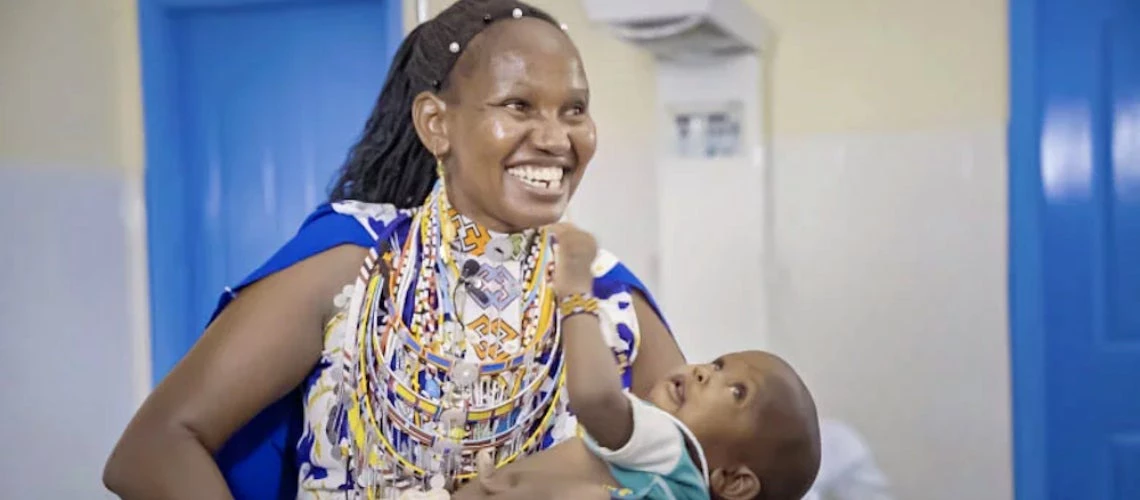 Janeffer Sarinke was able to deliver a healthy baby safely in the Shompole health center in Kajiado County, Kenya. She now educates others in her community on the importance of pregnancy care and safe births. Copyright: Davasha Photography/GFF
Janeffer Sarinke was able to deliver a healthy baby safely in the Shompole health center in Kajiado County, Kenya. She now educates others in her community on the importance of pregnancy care and safe births. Copyright: Davasha Photography/GFF
Despite intertwined crises – including debt, conflict, surging food and energy costs and climate change – many countries partnering with the Global Financing Facility (GFF) are making progress to improve the health of women, children and adolescents. This year’s annual report highlights four key takeaways:
- Long term commitment is key
The link between better health outcomes and a country’s long-term commitment to improving the lives of women and youth is clear: 96 percent of GFF partner countries have reduced maternal mortality and 94 percent have reduced under-five mortality, while the adolescent birth and under-five stunting rates have reduced in 76 and 75 percent of countries, respectively. Other statistics – for instance increases in severe wasting and stillbirths in some countries – serve as reminders that plenty of challenges remain.
The longer countries prioritize health and work, the stronger their progress: all countries partnering with the GFF for more than five years have seen improvements to maternal mortality rates, under-five mortality and adolescent birth rates.
For example, Kenya, one of the first countries to partner with the GFF, has leveraged the support of the GFF-IDA partnership. This has contributed to a reduction in under-five mortality by 21 percent, adolescent birth rate by 24 percent, and under-five stunting by 31 percent between 2014 and 2022. Similarly, Tanzania has more than doubled the share of its budget allocated to health – to more than 16 percent – while reducing maternal mortality rates by 82 percent. Côte d’Ivoire has scaled up its performance-based financing program to districts with lagging health outcomes, ensuring more resources flow to community health facilities.
- The data isn’t the complete picture: the impact on individuals and communities goes beyond numbers
Here are some highlights from the report: Kenya’s Kajiado county has more than 150 health centers today, compared with only 10 in the past. This has empowered women like Jannefer Sarinke who, after she was able to get good pregnancy care and deliver her baby safely, is now empowering others in her community. In Bangladesh, health counsellors like Fahima Akter are working to transform the lives of adolescents every day. In Liberia, a woman named Victoria launched an organization to provide safe spaces for adolescent sexual and reproductive health and rights. In Zimbabwe, Panashe Muchiringi benefits from an urban voucher program which provides services to pregnant women and new mothers in the lowest-income groups.
- We cannot rest amid a host of challenges; it will take deeper partnerships
While recognizing the strides that countries are making in advancing the health and rights of women and children, we also must confront an array of risks. I’m deeply worried about the impact of climate disasters, including cyclones and droughts, which disrupt health care services, displace households, destroy farmland and homes, and put women and children in an even more precarious position.
The GFF and the wider partnership—the World Bank, UN agencies, global health initiatives, bilateral donors, philanthropies, youth- and civil society organizations, and private sector—are well-positioned to support countries address their health priorities amid these challenges. We must all keep improving how we work together to support countries to build capacities, strengthen systems, and chart a path towards universal health coverage, which 196 members recommitted to at the last UN General Assembly.
- Significant investment is still needed to advance women’s health
The evidence is clear: this country-led approach is delivering progress in improving health outcomes and opportunities for women and children. While these achievements are encouraging, there is no time for complacency. Many governments across the world, including 35 of the 36 GFF partner countries, are still off track in meeting the 2030 goals for maternal, newborn and stillborn mortality reduction. Climate change and other challenges threaten to push the effort off course even further.
GFF partner countries are rising to the challenge—fulfilling this promise will require sustained commitment. This requires an even greater collective focus, increased priority on strengthening systems, more collaboration, and continued innovation and learning.
Explore the GFF Annual Report here.
To receive weekly articles, sign-up here


Join the Conversation